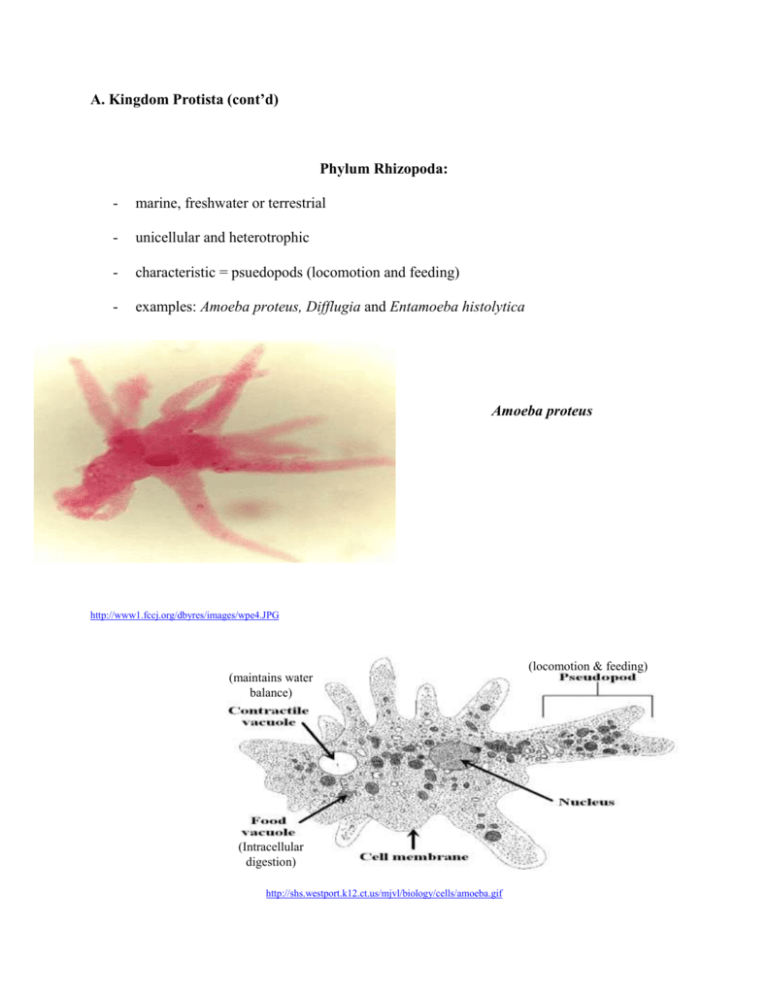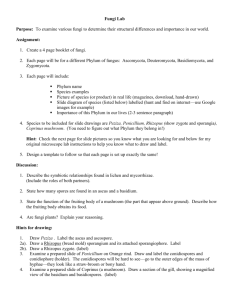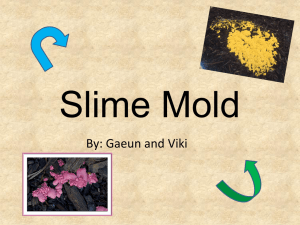Week 3
advertisement

A. Kingdom Protista (cont’d) Phylum Rhizopoda: - marine, freshwater or terrestrial - unicellular and heterotrophic - characteristic = psuedopods (locomotion and feeding) - examples: Amoeba proteus, Difflugia and Entamoeba histolytica Amoeba proteus http://www1.fccj.org/dbyres/images/wpe4.JPG (locomotion & feeding) (maintains water balance) (Intracellular digestion) http://shs.westport.k12.ct.us/mjvl/biology/cells/amoeba.gif http://www.uccs.edu/~rmelamed/MicroFall2002/Chapter%204/ameoba.jpg Difflugia Test (shell) psuedopodia - “Amoeba with a shell” - produces shell (test) from sand grains - sand is swallowed during fission and are passed to the daughter cells where they are joined together to form the shell http://www.stetson.edu/~kwork/difflugia%20with%20shell.jpg Entamoeba histolytica - intestinal parasite - trophozites have endosome that infects visceral tissues (intestines and liver) - trophozites encyst as they pass through the colon - cysts have 4 nuclei - spread through by fecal contamination of drinking water, raw vegetables and careless food handlers http://www.siamhealth.net/Disease/infectious/infection/Amebiasis_LifeCycle.gif Phylum Foraminifera (pore-bearing) - “shelled amoebas” - test (calcium carbonate) – multichambered (separated by septa) - symmetry of test is different from that of Difflugia - psuedopods ( perforate through pores in the shell) - some live near the ocean floor and deposit their shell on the ocean floor when they die - some are also planktonic - important in oil – extinct forms have been found in oil-bearing rocks http://bio.rutgers.edu/~gb102/lab_1/202am-foram.html Phylum Sarcomastigophora (fleshy whip bearer) - unicellular and heterotrophic - flagella present ( at least one) - example: Trypanosoma (caustitive agent of African sleeping sickness/Chaga’s disease) http://www.ucm.es/info/parasito/Trypanosoma.jpg http://www.umanitoba.ca/faculties/science/zoology/faculty/dick/z346/images/tryp2.jpg http://www.mt.mahidol.ac.th/eLearning/Parasite/Assets/trypanosoma%20gambiensecycle.gif Phylum Ciliophora (ciliates) - heterotrophic - hair-like cilia (locomotion & feeding) - cilia help to sweep food into the gullet - food is then taken to the food vacuoles - 2 types of nuclei (macro and micro) - micronuclei responsible for cell division - macronucleus responsible for normal cell functions - sexual reproduction by conjugation - asexual reproduction by longitudinal fission http://userwww.sfsu.edu/~biol240/labs/lab_06protists/media/paramecium.jpg Phylum Myxomycota - plasmodial slime mold - heterotrphic - multinucleate - amoeboid movement - similar to fungi but no cell wall of chitin - forms sporangia like fungi for dispersal of spores http://www.herbarium.usu.edu/fungi/FunFacts/SlimeMold.htm B. Kingdom Fungi - study of fungi = mycology - heterotrophic (parasitic or saprophytic) - live in symbiosis with some organisms - all contain hyphae (filaments of cytoplasm and nuclei enclosed by a cell wall) - collection of hyphae = mycelium - nuclei separated into cells by septae (no septae = coenoctytic (multinucleate)) - cell wall of chitin - extracellular digestion - asexual (spores, budding or fragmentation) or sexual reproduction - Classification: http://www.tolweb.org/Fungi (Vodopich and Moore, pg 273) Phylum Chytridiomycota - chytrids - most ancient fungi - aquatic - motile spores (zoospores) with flagella - example: Chytridium http://www.bsu.edu/classes/ruch/msa/porteretal/3-36.jpg Phylum Zygomycota - bread molds - terrestrial - zygosporangia formed from sexual reproduction - hyphae are multinucleate - example Rhizopus stolonifer (black bread mold) Rhizopus - root-like rhizoids (pigmented) at the base of the sporangiophores - isogamous http://www.csupomona.edu/~jcclark/classes/bot125/resource/graphics/g/zyg_rhi_clon1.jpg Life Cyle of Rhizopus Hyphae of + and – strains touch Sporangiophore (Vodopich and Moore, pg 275) Phylum Ascomycota - sac fungi - yeasts, molds, morels and truffles - some are economically important (Penicillium) - name from reproductive structure spores are produced in = ascus - asexual or sexual reproduction - asexual reproduction via conidia (Aspergillus and Penicillium) Apsergillus Penicillium http://botit.botany.wisc.edu/TOMS_FUNGI/images/a-flavus.jpg http://photos.imageevent.com/bobmetcalf/bio139labpractical1/websize/Penicillium%20sp%201.jpg - asexual reproduction by budding/fission (yeast) http://www.biochem.wisc.edu/yeastclub/buddingyeast(color).jpg - sexual reproduction via ascospores (morels and cup fungi) http://www.perspective.com/nature/fungi/ascomycota.html http://rainforest-australia.com/pics/Cup_fu28.jpg Ascocarp develops Dikaryotic mycelium 2 different strains mate http://faculty.ircc.edu/faculty/tfischer/images/ascomycota.jpg Phylum Basidiomycota - club fungi - mushrooms, puffballs, shelf fungi - rusts and smuts (parasites of plants) - cap, pileus and gills - spores produced in a basidium http://botit.botany.wisc.edu/images/332/Basidiomycota/Hymenomycetes/Agaricales/Armillaria/NABS_III_calvescens/A.calvescens_TJV94-21_5.jpg secondary http://faculty.ircc.edu/faculty/tfischer/images/basidiomycota%20life%20cycle.jpg Lichens - symbiotic relationship between an autotrophic algae and ascomycete - terrestrial - asexual reproduction - sensitive to air pollution - 3 growth forms: crustose (thallus grows close to substrate), foliose (adhere to substrate in sheets) and fructiose (grow away from substrate with erect stalks) http://images.google.com/imgres?imgurl=http://waynesword.palomar.edu/images/parmot1b.jpg&imgrefurl=http://waynesword.palomar.edu /pljan98f.htm&h=410&w=563&sz=86&hl=en&start=6&tbnid=pvhk4U68f_fwUM:&tbnh=97&tbnw=133&prev=/images%3Fq%3Dfoliose %2Blichen%26svnum%3D10%26hl%3Den







